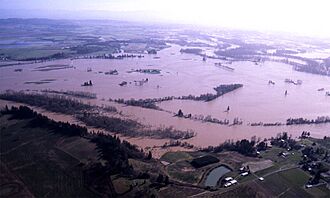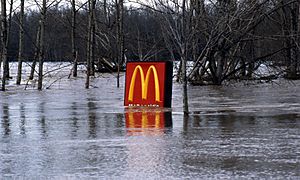1996 Pacific Northwest floods facts for kids

Flooding in the Willamette Valley in 1996.
|
|
| Date | February 1996 |
|---|---|
| Location | Washington, Oregon, and Idaho in the United States |
| Property damage | $700-$800 million ($1.4 billion in 2021) |
The 1996 Pacific Northwest floods were a series of big floods that hit parts of Washington, Oregon, and Idaho in the United States. These floods affected large areas around the Columbia River and Puget Sound. Cities like Portland, Yakima, and the Palouse region were impacted. The main reason for the floods was warm weather and heavy rain falling on a lot of snow. These floods caused about $800 million in damage back in 1996, which would be much more today.
Contents
How the Floods Started
The winter of 1995-1996 began with less snow than usual in many areas. Ski resorts even opened later than normal. But then, the weather changed. It started snowing a lot in lower areas. For example, Moscow, Idaho got 42 inches (107 cm) of snow in just ten days in late January.
After the heavy snow, it got very cold. The ground in many places, like the Columbia Basin, froze solid. In other areas, the ground was already full of water. This meant that when more water came, it couldn't soak into the ground.
The Pineapple Express Arrives
In early February, a big storm formed far away near Java. This storm was picked up by the jet stream, which is like a fast-moving river of air high in the sky. The jet stream pushed the storm towards the Pacific Northwest. When it arrived, it was called a "Pineapple Express". This is a special name for storms that bring a lot of moisture from the warm, tropical Pacific Ocean to the U.S. and Canadian west coast.
Conditions like La Niña helped guide this moisture. A high-pressure area over the Rocky Mountains and a low-pressure area near Aleutian Islands pushed the storm into Washington and Oregon instead of California. The rain started on February 6. On February 8, Seattle had its wettest February day ever, with 3.06 inches (78 mm) of rain at the airport.
Because the ground was either frozen or already soaked, the rain and melting snow had nowhere to go. This water stayed on the surface, causing widespread flooding.
Flood Impacts and Damage
The Columbia River itself did not flood as badly as it could have. This was thanks to dams and other flood control systems built after the big 1948 Columbia River flood. Only a few blocks in Vancouver had to be evacuated. Smaller rivers also had projects built in the 1960s that helped. For instance, a concrete channel for the Palouse River in Colfax, Washington prevented major flooding there. Experts believe that flood control in the Willamette Valley saved Portland alone from about $1.1 billion (1996 value) in extra damage. However, many other areas still experienced significant flooding.
Western Washington and Oregon Floods
The Willamette River in Portland reached 28.6 feet (8.7 m) on February 9. This was a major flood level. It caused flooding in low parts of the city, including an industrial area. Sandbags were placed along the downtown seawall to protect it. Further upstream, cities like Oregon City and Corvallis were also hit by the rising Willamette River. The water in Oregon City got so high that Willamette Falls almost disappeared.
Several rivers flowing from the Oregon Coast Range to the Pacific Ocean also flooded. In Tillamook County, about 500 dairy cattle drowned. Floodwaters also left mud and dirt covering a quarter of the grazing land.
Southwest Washington was also badly affected. Near Centralia and Chehalis, Interstate 5 was covered by up to 10 feet (3 m) of water. A dike built to protect the Chehalis-Centralia Airport overflowed. The Skookumchuck River reached a new record for how much water it was carrying. The Chehalis River and Cowlitz River also rose far above flood levels. Further south, a mudslide near Woodland also closed Interstate 5.
Many roads in King County were washed away. One man died when he drove into a 40-foot (12 m) deep hole where a road used to be. Parts of Kent and Renton flooded. A landslide in Tacoma caused a house to slide into the Tacoma Narrows. Seattle did not have major flooding because it is between the Puget Sound and Lake Washington. However, the city could not get water from the Cedar River because it had too much mud in it.
Inland Northwest Floods
About 11 inches (279 mm) of rain fell on the east side of Snoqualmie Pass in three days. This caused the Yakima River to rise quickly. Similar amounts of rain fell near the start of the Naches River, which flows into the Yakima. Most towns from Nile in the Cascade Mountains to Toppenish were damaged.
Visitors at a country club in Yakima got stuck when a large ice jam blocked the river. This cut off their access, and military vehicles had to be used to rescue them. Interstate 82 near Granger was closed due to flooding. Mud and dirt from a smaller river flowing into the Naches River forced the closure of State Route 410.
Near Milton-Freewater, south of Walla Walla, Mill Creek rose so high that helicopters were needed to evacuate people. In St. Maries, Idaho, four levees broke because of high water and damage from ice. U.S. Route 95 and U.S. Route 12 were closed in Idaho. Tugboats had to be used on Lake Coeur d'Alene to stop a restaurant boat from floating away from its dock. The University of Idaho closed after some student housing on campus was flooded by Paradise Creek.


